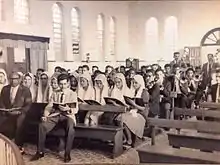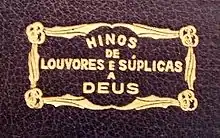Christian Congregation in Brazil
The Christian Congregation in Brazil (Portuguese: Congregação Cristã no Brasil) was founded in Brazil by the Italian-American missionary Luigi Francescon (1866–1964), as part of the larger Christian Congregation movement.
| Christian Congregation in Brazil | |
|---|---|
.jpg.webp) | |
| Founder | Luigi Francescon |
| Origin | 1910 Santo Antônio da Platina (PR) |
| Congregations | 24.272 in Brazil (2021[1]) |
| Members | 2.5 million (2000) 2.8 million (2016)[2] |
| Official website | congregacaocristanobrasil.org.br |
History

Louis Francescon came for the first time to Brazil from Chicago, Illinois in 1910. After arriving in São Paulo, Francescon went to Santo Antonio da Plantina, Paraná.[3] His eleven missionary trips were quite successful among fellow Italian immigrants and Brazilian nationals.
The Christian Congregation of Brazil is one of the most dynamic and it is fast-growing.[4] In 2016, the Christian Congregation in the Brazil had around 2.8 million members[5][6] in 2020 and 24,272 temples (2021) in that country and more than 50,000 temples in all world and an intense missionary work abroad. In the metro area of São Paulo, the church shows its strength: there are 500,000 followers, distributed in 2,000 churches and a mother-church in the Brás district that houses a 9,800 member congregation in the Brás district.
Francescon was among the early founders of the Italian-American Pentecostal church in Chicago. He had left the First Italian Presbyterian Church of Chicago because of his belief in Water Baptism by immersion. Later, he accepted the doctrines of anointing with oil, miracles, and Holy Spirit baptism at the North Avenue Full Gospel Mission led by William Howard Durham. Evangelists from Chicago went to the Italian colonies in the United States planting churches mostly in the Northeast. Most of those churches were incorporated into the Christian Church of North America, with a few affiliated with the Christian Congregation in the United States.
Principles

The beliefs of the Christian Congregation takes the 12 Articles of Faith as fundamental basis for their religious principles. They believe in the Holy Trinity, the Bible, divine interventions and miracles. The members are baptised in the name of Jesus Christ, for the cleansing of their sins, and the promise of salvation and eternal life after their passing.[7]
The 12 Articles of Faith:[8]
- We believe and accept the entire Holy Bible as the infallible Word of God, inspired by the Holy Spirit; it is the only perfect order of our faith and manner of living, where nothing can be added or taken away, which is the power of God to save every believer. (II Peter 1:21; II Timothy 3:16,17; Romans 1:16)
- There is only one living and true God, eternal, with infinite power, Creator of all things; and in the unity of Him there are three distinct Persons: the Father, the Son and the Holy Spirit. (Ephesians 4:6; Matthew 28:19, I John 5:7)
- Jesus Christ, the Son of God, is the Word of God, who assumed the human nature through virgin Mary, having two natures in one, the divine and the human; therefore He is the only saviour, who suffered for the sins of mankind granting us salvation and eternal life. (Luke 1:27-35; John 1:14; I Peter 3:18)
- We believe in the existence of the devil and his angels who live amongst us; evil spirits that together will be punished in everlasting fire. (Matthew 25:41)
- We believe that the regeneration, or rebirth, is received only through faith in Jesus Christ, who was delivered to the world to suffer for our sins and grant us salvation. Those who are cleansed through His blood, are new creatures, and have Him for wisdom, righteousness, sanctification and redemption. (Romans 3:24,25; I Corinthians 1:30, II Corinthians 5:17)
- We believe in the baptism, performed in the Name of Jesus Christ (Acts 2:38), with a single immersion, in the Name of the Father, the Son and of the Holy Spirit. (Matthew 28:18-19)
- We believe in the baptism of the Holy Spirit with the sign of speaking with other tongues as the Spirit gives utterance. (Acts 2:4, 10:45-47; 19:6)
- We believe in commemorating the Lord's Supper. The same night Jesus Christ was betrayed, He took the bread, broke it in pieces and said "Eat this bread, as it represents my body, do so in remembrance of me. After, he took the cup of wine and said "This cup is the new testament in my blood, which is shed for you. (Luke 22:19-20; I Corinthians 11:23-25)
- It is necessary to abstain from things offered to idols, and from blood, and from strangled animals, and from fornication, as decreed by the Holy Spirit in the general assembly held in Jerusalem. (Acts 15:28-29, 16:4; 21:25)
- Jesus Christ took upon Himself our sicknesses. "Is there any sick among you? Let him call for the elders of the church. and let them pray over him, anointing him with oil in the Name of the Lord. And the prayer of faith shall save the sick and the Lord shall raise him up; and if he have committed sins, they shall be forgiven." (Matthew 8:17, James 5:14-15)
- We believe that the Lord, (before the millennium) shall descend from heaven with a shout, with the voice of the archangel, and with the trump of God: and the dead in Christ shall rise first: then we who are alive and remain shall be caught up together with them in the clouds to meet the Lord; and so we shall ever be with the Lord. (I Thessalonians 4:16- 17; Revelation 20:6)
- The dead shall rise again, both of the just and the unjust. Those will be doomed into everlasting punishment; but the righteous will earn eternal life. (Acts 24:15; Matthew 25:46)
The church and services
Congregational worship is held at churches, and they hold two important services apart from the normal weekday services - Baptism, which is done once in a person's lifetime, and the Holy Supper, which is held at church once a year (or more, for those who missed the official day). Hymns[9] are chanted accompanied by an orchestra - one of the largest orchestras in the world, with more than 750,000 musicians worldwide. Inside the church, the men and the women sit on opposite sides of each other. Man and women often dress in modest attires, with the women wearing white veils, dresses or skirts, and the men often dressing in suits. The inscription "In the Name of the Lord Jesus" is written above the pulpit, to symbolize that the services are held in the name of Jesus Christ. Services are usually ministrated by a cooperator, a deacon, or an elder from the ministry. Usually, with bigger churches, there can also be a fountain behind the pulpit for the occasional baptism services, which usually happens once a month.
References
- Relatorio
- "Pentecostalism in Brazil". The Economist. 12 December 2021. Retrieved 24 January 2016.
- J. Gordon Melton and Martin Baumann, Religions of the World: A Comprehensive Encyclopedia of Beliefs and Practices, ABC-CLIO, USA, 2010, p. 621
- Read, William R. New Patterns of Church Growth in BrazilGrand Rapids: William B. Eerdmans Publishing Company, 1965.
- Jeff Oliver, Pentecost To The Present Book Three: Worldwide Revivals and Renewal, Bridge Logos Inc, USA, 2016, p. 77
- 2000 Brazilian Census IBGE
- "Estatuto - Congregação Cristã no Brasil".
- "Pontos de Doutrina - Congregação Cristã no Brasil".
- Hymns of Praise and Supplication to God. USA: CHRISTIAN CONGREGATION IN THE UNITED STATES. 1998.
- ALVES, Leonardo M. "Christian Congregation in North America: Its Inception, Doctrine, and Worship". Dallas, 2006.
- FRANCESCON, Louis. "Faithful Testimony". Chicago, 1952.
- HOLLENWEGGER, Walter. "The Pentecostals".Minneapolis, 1972.
External links
- Official website of the Christian Congregation of the /WORLD
- Official website of the Christian Congregation of the /BRAZIL
- Official website of the Christian Congregation /USA
- Official website of the Christian Congregation /AUS
- Official website of the Christian Congregation /UK
- Official website of the Christian Congregation of the Uruguay /UY